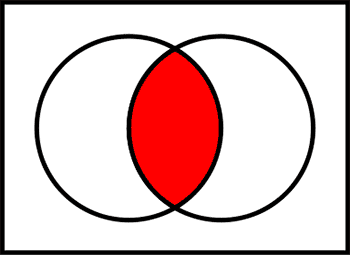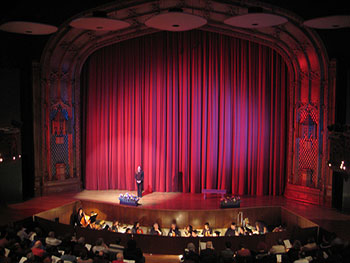
Source: Venn0001, Wikimedia
At one time or another while in school, you probably used a graphic organizer or a type of visual aid, such as a Venn diagram like the one shown on the left, to help you more clearly see the information you need to know. When you see a Venn diagram, you know right away that you are examining two different ideas in the outer circles, and then you find what they have in common in the area that overlaps. In other words, the form of the visual aid gives you an idea about what kind of meaning you are looking for—in this case similarities and differences between two ideas or topics.
Graphic elements in poetry can help you in ways that are similar to using a Venn diagram. The choices a poet makes about line lengths, stanzas, capital letters, and word positions are some of the many clues that help you discover what the poem means. Watch this video to get an idea of some of the graphic elements that poets may use.
Source: Poetic Techniques: Sound Devices and Graphic Elements, Ty Hoppe, YouTube.com
Capital Letters
Now consider each of these elements one at a time. When you write a paragraph, what kind of letter begins the first word of each sentence? Of course, you know it's a capital letter. Poets most often begin each line of a poem with a capital letter, as in the following example.
Openin’ Night
By Shel Silverstein
She had the jitters
She had the flu
She showed up late
She missed her cue
She kicked the director
She screamed at the crew
And tripped on a prop
And fell in some goo

Source: The Stage, feminstjulie, Flickr
However, because poetry is such a special form of writing, poets may choose to capitalize words in different places in the lines or even not at all depending on their style and the meanings they want to convey. Carefully read the example below and click to highlight any capitalized words

If—
By Rudyard Kipling
If you can keep your head when all about you
Are losing theirs and blaming it on you,
If you can trust yourself when all men doubt you,
But make allowance for their doubting too;
If you can wait and not be tired by waiting,
Or being lied about, don’t deal in lies,
Or being hated, don’t give way to hating,
And yet don’t look too good, nor talk too wise:
If you can dream—and not make dreams your master;
If you can think—and not make thoughts your aim;
If you can meet with Triumph and Disaster
And treat those two impostors just the same;
If neither foes nor loving friends can hurt you,
If all men count with you, but none too much;
Yours is the Earth and everything that’s in it,
And—which is more—you’ll be a Man, my son!
In this first example, notice that in addition to the first word of each line being capitalized, four other words are capitalized.
Now you will practice making some inferences about Kipling’s use of capital letters. Read the following example of a discussion using inferences to determine why Kipling might have used capital letters in the poem in the way that he did. Then click on Think Aloud for an explanation.

Notice that good inferences always include evidence from the text!
Now read the next poem carefully, and click to highlight the capitalized words. You may also highlight words in blue if necessary.

Look over your highlighted words, and then click to reveal which categories of words the poet capitalizes in this poem.

 Now try to make an inference about the importance of the capitalized words in relation to the meaning of the poem. Use your notes to write a statement about why you think these words are capitalized, and be sure to include text evidence in your answer, which you can write in the line below. When you are finished, check your understanding to see a sample response.
Now try to make an inference about the importance of the capitalized words in relation to the meaning of the poem. Use your notes to write a statement about why you think these words are capitalized, and be sure to include text evidence in your answer, which you can write in the line below. When you are finished, check your understanding to see a sample response. Sample Response:
Dickinson seems to be describing something important, something that is beyond ‘This world’ and ‘Invisible’ but is ‘positive.’ I think she uses capital letters to emphasize that this ‘Species’ is real and exists even though people can’t see it, similar to ‘Music’ or ‘Sound.’